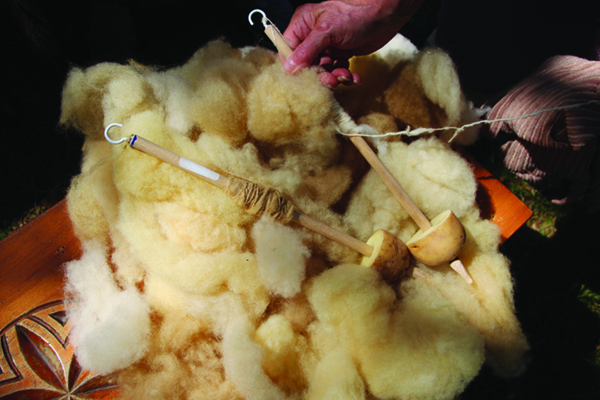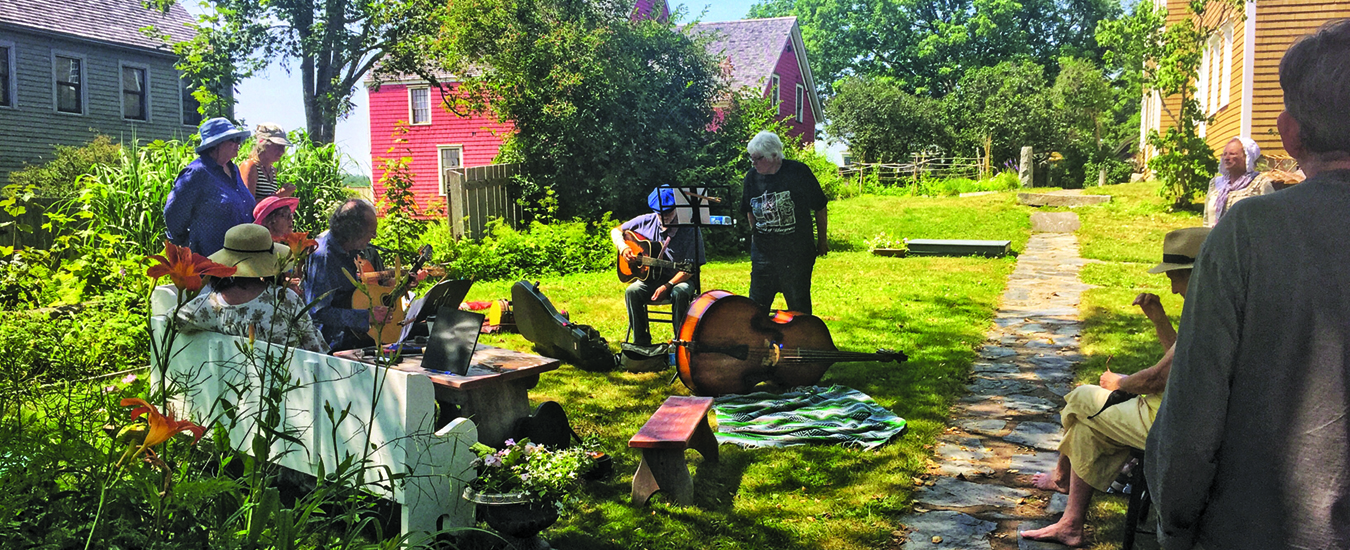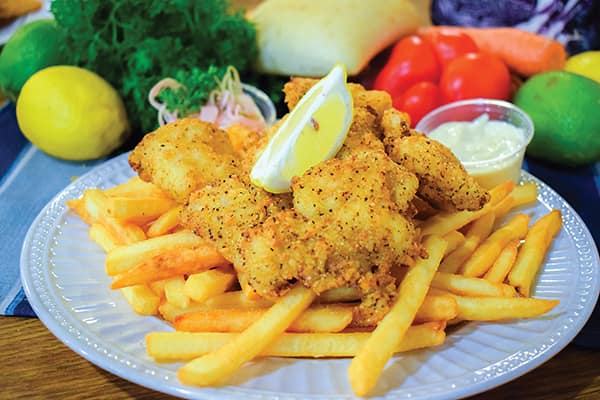Making candles and other timeless talents
Story and photography by Darcy Rhyno
As a cicada buzzes in the summer heat, I’m making a candle in the shade beside a young Loyalist-for-a-day. She dips a wick into hot beeswax, then plunges it into cold water to help set the wax. Out it comes again and back into the liquid wax, each time building another layer.
It’s important to allow the candle to cool in the water, especially on hot summer days like this, so sometimes kids are asked to take a lap around the table before removing the candle from the water and immersing it into the hot wax again. In no time, the kid’s candle grows to a usable size. Her candle is smooth and uniform compared to my lumpy one shaped more like a pear than a candlestick.
“I could do this all day,” says the girl dressed in period Loyalist clothing–a white bonnet, shawl and apron over an ochre coloured, full length dress–living life as if it were the 1780’s when thousands of those who wished to remain loyal to the British crown migrated from the newly independent United States to Shelburne and other parts of what would become Canada.
“I know. It’s so zen, isn’t it,” says Greta Mossman, Senior Interpreter at the Ross-Thomson House and Store Museum. The hands-on candle making experience is part of the 18th Century Afternoon that includes, from time to time, activities like butter churning, soap making and construction of a traditional toy called a Jacob’s ladder. “We never have nothing going on,” Mossman says of the museum’s many activities. As we work, she tells us stories, building layers of history as if she’s dipping a candle.

Candles, switchel and yarn
“These were time consuming,” Mossman says of the candles we're making. “In the 18th century, your wealth was determined by the quality of your fabric and the quantity of your candles. Because they were disposable, if you were burning high quality candles, you were wealthy enough to burn your money, so to speak.” Instantly, I have a new appreciation for my lumpy work because of the time, labour and scarce family resources that must have gone into creating a light source for the household.
Mossman continues her interpretative comments with a story from the life of George Washington. “To prove how wonderful the new country of the United States was after the Revolutionary War, all day his entire place would be festooned with the most gorgeous beeswax candles. But at night, as soon as the last visitor left, they’d take the candles away and give everybody a little stub of tallow candle. The next day, they would put the beeswax candles out again to show the prosperity of the new nation.”
Washington features prominently in our next activity as well, the making of switchel. “It’s the 18th century version of Gatorade,” Mossman says. “This recipe came directly out of George Washington’s diaries. Another name for it is haying water because they could send slaves and indentured servants out into the field to do the haying when it was very dry and hot.”
Mossman’s enthusiasm for all things Loyalist is infectious. She’s such a committed interpreter, she’s pulled her husband Rod Mossman into the museum as a volunteer. A classically trained musician and retired music teacher, Rod hosts an 18th century music jam every Monday afternoon right here in the shaded garden. While Rod awaits the arrival of other musicians, he joins our hands-on activities.
“Washington also used it for his troops,” Rod says. He tells us how he mixes up his own switchel at home as his drink of choice when he’s training for marathons. “If you added rum, it was grog.”
“The ingredients were readily available and inexpensive at that time,” Greta says. These include brown sugar, molasses, cider vinegar and ground ginger. Cider vinegar is a replacement for the lime juice added to the original grog, a mix that helped prevent scurvy aboard British Navy ships.
Visitors can participate in the preparation of other historical drinks as well to literally get a taste of 18th century history. Greta Mossman and other museum staff brew dandelion root coffee with plants from the museum grounds and mix lemonade from citric acid. “It was called fairground lemonade,” Mossman says. “It was considered the cotton candy of the 18th century. Kids would arrive carrying their own mugs to the fair and get their citric acid lemonade, a big treat.”
As we sip our switchel, Greta Mossman tells us about an autumn activity she enjoys leading. When families gather on the waterfront at Halloween to carve pumpkins into jack-o’-lanterns, the museum hosts turnip carving for kids. “Pumpkins weren’t a thing that they had at the time,” Mossman says. “So, they used turnips, hollowed them out and made little faces in them. It was so cute. Just so adorable,” she adds, by which she must mean ugly, given that the carved turnip heads would eventually shrivel. “They’re big turnips, but when they dry, they look like little shrunken heads.”
After a last sip of switchel, I turn my hand to spinning wool. Greta Mossman holds up a roka, a y-shaped stick also called a distaff, used to spin wool into yarn. She gives it a twirl, magically pulling a string of yarn from a fuzzy ball of wool sheered from local sheep. As she spins, she tells us that yarn got its colours in the 18th century from natural dyes made with things like yarrow and onion skins. “As we spin the wools together, we’re getting beautiful natural variations of colours.”
Museums by the Sea
The Ross-Thomson House and Store Museum is part of Museums by the Sea on Shelburne’s waterfront, a collection of a dozen buildings and inviting green spaces. Sharing back yards with the Ross-Thomson House is the Shelburne County Museum, which interprets local history like the lobster fishery and the town’s shipbuilding heritage. It’s also home to Canada’s oldest fire pumper, a 1740 Newsham, equipped with a hand pump, wooden wheels and a leather bucket.
Visitors to the J.C. Williams Dory Shop Museum can lend a hand, building an authentic Shelburne-style wooden dory, which served the great schooners that fished the Grand Banks. Leading the work is a master dory builder like those from the past who constructed thousands over a lifetime. Today, visitors can try rowing one of these historic boats in the harbour next to the museum.
The Coyle House, painted fire engine red, welcomes visitors inside to Tottie’s Crafts where volunteers sell their own traditional quilts, hooked rugs and giftware, as well as pottery and other works by professional artists. All sales proceeds go to support the museum complex.
Recently spruced up for visitors, the Muir-Cox Shipyard Saw and Planing Mill tells the history of Shelburne’s once booming ship building trade. The mill seems precariously balanced on stacks of rough cut granite stone, but it was built by shipwrights, so it’s as solid as any ship’s hull constructed from the lumber milled here. It’s run by volunteers fascinated with its history and the secret workings of the machinery inside. Occasionally, a giant saw blade rips timber into lumber. This and other machinery is brought to life again by a century-old engine that powers all the gears, shafts and huge connecting belts, making the building hum like it did in its heyday.
There’s so much to do on Shelburne’s historic waterfront, visitors will need more than a day to try all the hands-on activities and experiences the museums have to offer. The best way for a family to make the most of Museums by the Sea is to time a visit with a special event like Founders Days, held every year in July. Kids will enjoy all the carnival-like fun while getting a chance for a deep immersion into 18th century life. That’s because on such special occasions, the waterfront is often transformed into a re-enactment encampment, complete with canvas tents, cook outs, military drills and even the firing of cannons.
At events like this, it’s as if the whole waterfront has slipped 250 years into the past when blacksmiths, British soldiers, carpenters and Indigenous peoples mingled and went about their business. Children and adults alike can join these characters, reimagining 18th century life back into being.
7 Nearby Attractions
1. Black Loyalist Heritage Centre to learn about Black Loyalist history.
2. The Barrel Factory where wooden barrels are still
3. The Osprey Arts Centre for local music and other
4. Guild Hall for Saturday morning markets andspecial events.
5. Charlotte Lane Café for dining just steps from the Ross-Thomson House, a former winner of Nova Scotia’s Best Small Restaurant of the Year award.
6. Boxing Rock Taproom to sample Shelburne’s own craft beer.
7. Sandy Point Lighthouse, at the mouth of the harbour, visible from the historic waterfront.
Header caption: Afternoon 18th century music jam at Ross-Thomson House and Store Museum.
Intro caption: Ross-Thomson House and Store Museum.



